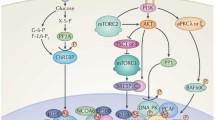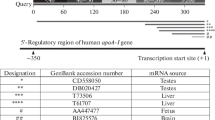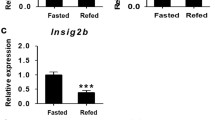Abstract
Fatty acid translocase (FAT)/CD36 is a multi-functional membrane protein participating in uptake of long-chain fatty acids and oxidized low density lipoprotein, playing an important role in lipid homeostasis. We reported the dual promoter structures of the mouse and human FAT/CD36 genes in relation to the tissue-specific expression and regulation by peroxisome proliferator-activated receptors (PPARs) (Sato et.al. J. Biol. Chem. 277, 15703–15711, 2002). However, these structures alone could not explain a large induction of the mRNA by a PPAR ligand in the mouse intestine. To learn more about the tissue-specific transcriptional regulation of the FAT/CD36 gene for lipid homeostasis at the whole body level, we cloned the cDNA for the induced mRNA in the mouse intestine and identified third promoter close to the first common exon of the gene. The human gene also has essentially the same gene organization. RT-PCR and Northern blot analyses showed that the three promoters are differentially used in various mouse tissues and the cultured human cells. The physiological significance of these complex promoter structures was suggested by the differential responsiveness to a peroxisome proliferator-activated receptor ligand and the differences in translational efficiencies or stabilities of the mRNA among the isoforms. (Mol Cell Biochem xxx: 1–7, 2004)
Similar content being viewed by others
Abbreviations
- BAT:
-
brown adipose tissue
- FAT:
-
fatty acid translocase
- LPL:
-
lipoprotein lipase
- LXR:
-
liver X receptor
- PPAR:
-
peroxisome proliferator-activated receptor
- RACE:
-
rapid amplification of cDNA ends
References
Silverstein RL, Febbraio M: CD36 and atherosclerosis. Curr Opin Lipidol 11: 483–491, 2000
Asch AS, Barnwell J, Silverstein RL, Nachman RL: Isolation of the thrombospondin membrane receptor. J Clin Invest 79: 1054–1061, 1987
Abumrad NA, el-Maghrabi MR, Amri EZ, Lopez E, Grimaldi PA: Cloning of a rat adipocyte membrane protein implicated in binding or transport of long-chain fatty acids that is induced during preadipocyte differentiation. Homology with human CD36. J Biol Chem 268: 17665–17668, 1993
Endemann G, Stanton LW, Madden KS, Bryant CM, White RT, Protter AA: CD36 is a receptor for oxidized low density lipoprotein. J Biol Chem 268: 11811–11816, 1993
Nicholson, AC, Frieda S, Pearce A, Silverstein RL: Oxidized LDL binds to CD36 on human monocyte-derived macrophages and transfected cell lines. Evidence implicating the lipid moiety of the lipoprotein as the binding site. Arterioscler Thromb Vasc Biol 15: 269–275, 1995
Rigotti A, Acton SL, Krieger M: The class B scavenger receptors SR-BI and CD36 are receptors for anionic phospholipids. J Biol Chem 270: 16221–16224, 1995
Savill J, Hogg N, Ren Y, Haslett C: Thrombospondin cooperates with CD36 and the vitronectin receptor in macrophage recognition of neutrophils undergoing apoptosis. J Clin Invest 90: 1513–1522, 1992
Ren Y, Silverstein RL, Allen J, Savill J: CD36 gene transfer confers capacity for phagocytosis of cells undergoing apoptosis. J Exp Med 181: 1857–1862, 1995
Oquendo P, Hundt E, Lawler J, Seed B: CD36 directly mediates cytoadherence of Plasmodium falciparum parasitized erythrocytes. Cell 58: 95–101, 1989
Moore K J, El Khoury J, Medeiros LA, Terada K, Geula C, Luster AD, Freeman MW: A CD36-initiated signaling cascade mediates inflammatory effects of β-amyloid. J Biol Chem 277: 47373–47379, 2002
Febbraio M, Hajjar DP, Silverstein RL: CD36: a class B scavenger receptor involved in angiogenesis, atherosclerosis, inflammation, and lipid metabolism. J Clin Invest 108: 785–791, 2001
Nicholson AC: Oxidized LDL binds to CD36 on human monocyte-derived macrophages and transfected cell lines. Evidence implicating the lipid moiety of the lipoprotein as the binding site. Trends Cardiovasc Med 14: 8–12, 2004
Sato O, Kuriki C, Fukui Y, Motojima K: Dual promoter structure of mouse and human fatty acid translocase/CD36 genes and unique transcriptional activation by peroxisome proliferator-activated receptor α and γ ligands. J Biol Chem 277: 15703–15711, 2002
Kuriki C, Tanaka T, Fukui Y, Sato O, Motojima K: Structural and functional analysis of a new upstream promoter of the human FAT/CD36 gene. Biol Pharm Bull 25: 1476–1478, 2002
Nagy L, Tontonoz P, Alvarez JG, Chen, H, Evans RM: Oxidized LDL regulates macrophage gene expression through ligand activation of PPARγ. Cell 93: 229–240, 1998
Tontonoz P, Nagy L, Alvarez JG, Thomazy VA, Evans RM: PPARγ promotes monocyte/macrophage differentiation and uptake of oxidized LDL. Cell 93: 241–252, 1998
Chomczynski P, Sacchi N: Single-step method of RNA isolation by acid guanidinium thiocyanate-phenol-chloroform extraction. Anal Biochem 162: 156–159, 1987
. Motojima K, Passilly P, Peters JM, Gonzalez FJ, Latruffe N: Expression of putative fatty acid transporter genes are regulated by peroxisome proliferator-activated receptor α and γ activators in a tissue- and inducer-specific manner. J Biol Chem 273: 16710–16714, 1998
Schoonjans K, Peinado-Onsurbe J, Lefebvre AM, Heyman RA, Briggs M, Deeb S, Staels B, Auwerx J: PPARα and PPARγ activators direct a distinct tissue-specific transcriptional response via a PPRE in the lipoprotein lipase gene. EMBO J 15: 5336–5348, 1996
Chawla A, Boisvert WA, Lee CH, Laffitte BA, Barak Y, Joseph SB, Liao D, Nagy L, Edwards PA, Curtiss L K, Evans RM, Tontonoz P: A PPAR γ-LXR-ABCA1 pathway in macrophages is involved in cholesterol efflux and atherogenesis. Mol Cell 7: 161–171, 2001.
Griffin E, Re A, Hamel N, Fu C, Bush H, McCaffrey T, Asch AS: A link between diabetes and atherosclerosis: Glucose regulates expression of CD36 at the level of translation. Nat Med 7: 840–846, 2001
Author information
Authors and Affiliations
Corresponding author
Rights and permissions
About this article
Cite this article
Sato, O., Takanashi, N. & Motojima, K. Third promoter and differential regulation of mouse and human fatty acid translocase/CD36 genes. Mol Cell Biochem 299, 37–43 (2007). https://doi.org/10.1007/s11010-005-9035-0
Received:
Published:
Issue Date:
DOI: https://doi.org/10.1007/s11010-005-9035-0




